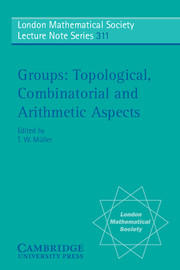Book contents
- Frontmatter
- Contents
- List of authors and participants
- Preface
- 1 Reductive groups as metric spaces
- 2 Finiteness properties of groups acting on twin buildings
- 3 Higher finiteness properties of S-arithmetic groups in the function field case I
- 4 Controlled topology and group actions
- 5 Finiteness properties of soluble S-arithmetic groups – A survey
- 6 Topology in permutation groups
- 7 Euler characteristics of discrete groups
- 8 Intersections of Magnus subgroups of one-relator groups
- 9 A minimality property of certain branch groups
- 10 Lattices with non-integral character
- 11 Some applications of probability in group theory
- 12 Parity patterns in Hecke groups and Fermat primes
- 13 Automorphisms of the binary tree: state-closed subgroups and dynamics of 1/2-endomorphisms
- 14 The mapping class group of the twice punctured torus
- 15 Kac–Moody groups: split and relative theories. Lattices
- 16 On the finite images of infinite groups
- 17 Pseudo-finite generalized triangle groups
1 - Reductive groups as metric spaces
Published online by Cambridge University Press: 04 November 2009
- Frontmatter
- Contents
- List of authors and participants
- Preface
- 1 Reductive groups as metric spaces
- 2 Finiteness properties of groups acting on twin buildings
- 3 Higher finiteness properties of S-arithmetic groups in the function field case I
- 4 Controlled topology and group actions
- 5 Finiteness properties of soluble S-arithmetic groups – A survey
- 6 Topology in permutation groups
- 7 Euler characteristics of discrete groups
- 8 Intersections of Magnus subgroups of one-relator groups
- 9 A minimality property of certain branch groups
- 10 Lattices with non-integral character
- 11 Some applications of probability in group theory
- 12 Parity patterns in Hecke groups and Fermat primes
- 13 Automorphisms of the binary tree: state-closed subgroups and dynamics of 1/2-endomorphisms
- 14 The mapping class group of the twice punctured torus
- 15 Kac–Moody groups: split and relative theories. Lattices
- 16 On the finite images of infinite groups
- 17 Pseudo-finite generalized triangle groups
Summary
Introduction
In this paper four descriptions of one and the same quasi-isometry class of pseudo-metrics on a reductive group G over a local field are given. They are as follows. The first one is the word metric corresponding to a compact set of generators of G. The second one is the pseudo-metric given by the action of G by isometries on a metric space. That these two pseudo-metrics on a group G are quasi-isometric holds in great generality. The third pseudo-metric is defined using the operator norm for a representation ρ of G. This pseudo-metric depends very much on the representation. But for a reductive group over a local field it does not up to quasi-isometry. The fourth pseudo-metric is given on a split torus over a local field K by valuations of the K*–factors. The main result is that these four pseudo-metrics on a reductive group over a local field coincide up to quasi-isometry. We thus have four different descriptions of one and the same very natural and distinguished quasi-isometry class of pseudo-metrics.
This paper contains foundational material for joint work in progress with G. A. Margulis on the following two topics. One is work on the following question of C. L. Siegel's. Given a reductive group G over a local field and an S–arithmetic subgroup Γ of G, it is one of the main results of reduction theory to describe a fundamental domain R for Γ in G, a so called Siegel domain.
- Type
- Chapter
- Information
- GroupsTopological, Combinatorial and Arithmetic Aspects, pp. 1 - 20Publisher: Cambridge University PressPrint publication year: 2004
- 1
- Cited by



